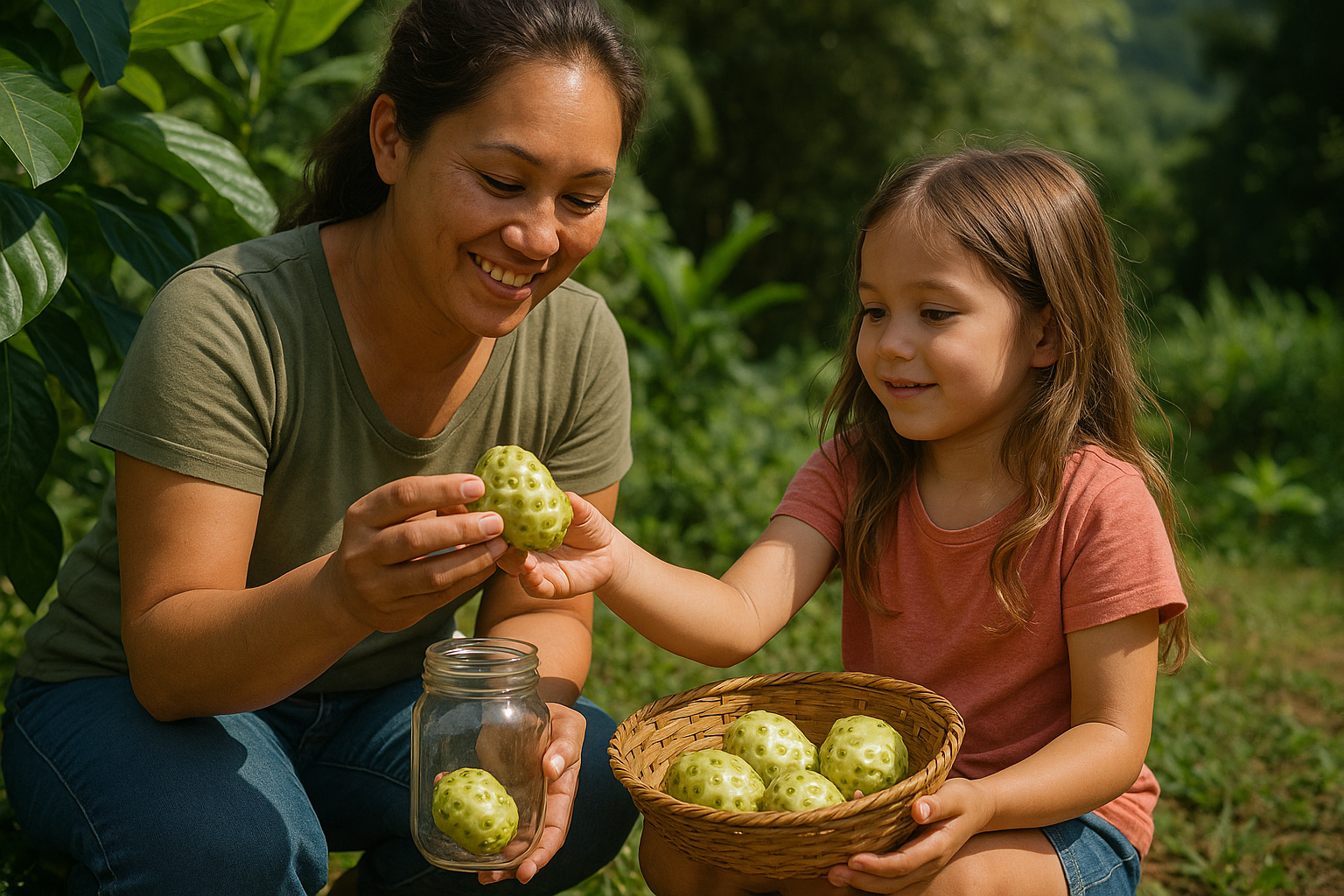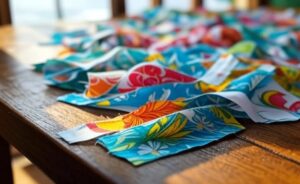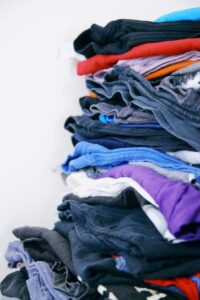
Want to spark your child’s curiosity about Hawaii’s natural resources while teaching them to care for our ʻāina (land)? This fun, family-friendly activity, inspired by the Ka Pilina Noʻeau Hoʻomau kindergarten lesson “Ahupuaʻa Community Connections & Ahupuaʻa Natural Resources Diagram,” invites your ʻohana to make eco-friendly cleaners using Hawaiian plants like noni and kukui. Your keiki will explore the ahupuaʻa’s gifts, practice counting, and learn the value of mālama ʻāina (caring for the land) in a hands-on way. Perfect for little learners, this activity weaves in Hawaiian culture and kindergarten-level skills for a meaningful at-home experience.
Why This Activity?
In the Ka Pilina Noʻeau Hoʻomau curriculum, kindergarteners learn about the ahupuaʻa, the traditional Hawaiian land division that provides natural resources like plants, water, and food. They draw and describe these resources while practicing counting and writing numbers (aligned with standards like CCSS.MATH.CONTENT.K.CC.A.3 and K-ESS3-1). This activity connects directly to those goals by using Hawaiian plants as natural resources to create cleaners, helping keiki understand how the ʻāina supports us. By making non-toxic cleaners, you’ll also protect Hawaii’s ecosystems—like our coral reefs and watersheds—while teaching your child kuleana (responsibility) to care for the environment.
What You’ll Need
Gather these simple items, many already in your home. For Hawaiian plants, check your backyard or local markets, and always harvest respectfully, taking only what you need. If plants aren’t accessible, use household substitutes.
- Hawaiian Plants (natural resources from the ahupuaʻa):
- Noni (Morinda citrifolia) fruit or juice: A traditional healing plant with antiseptic properties.
- Kukui (Candlenut) leaves or oil: Symbolizes enlightenment and adds a gentle shine.
- Household Items:
- White vinegar (dissolves stains).
- Baking soda (deodorizes and scrubs).
- Lemon or lime juice (adds fragrance).
- Liquid castile soap (gentle, plant-based).
- Small jars or containers (for mixing cleaners), measuring spoons/cups, microfiber cloths.
- Optional: Paper, crayons, or markers for drawing an ahupuaʻa diagram.
- Safety: Gloves (noni may irritate skin), labels for containers, adult supervision.
Let’s Get Started: A Kindergartener’s Adventure
This activity takes about 45 minutes and is designed for kindergarteners with family help. It’s a chance to explore, create, and connect to the ahupuaʻa.
Step 1: Talk Story About the Ahupuaʻa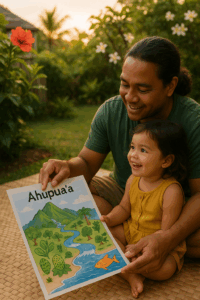
Gather your keiki in a cozy spot—maybe your kitchen or backyard—and talk about the ahupuaʻa, the Hawaiian system that stretches from mountain to sea, providing resources like plants and water. Ask: “What gifts does the ʻāina give us? How can we take care of it?” Share that plants like noni and kukui are special resources used by kūpuna (elders) for healing and daily life. Explain that making cleaners with these plants helps keep our kai (sea) and ʻāina clean, protecting animals like the Hawaiian monk seal.
Step 2: Explore Natural Resources (Optional Gathering)
If you have access to noni fruit or kukui leaves, take a short family walk to find them (with permission from the land or a community garden). Use this as a chance to count: “How many noni fruits do we see? Let’s count 1, 2, 3!” ( aligns with CCSS.MATH.CONTENT.K.CC.B.5). If gathering isn’t possible, use store-bought noni juice or kukui oil, or focus on household items like lemons. Talk about how these are gifts from the ahupuaʻa, just like fish or kalo.
 Step 3: Make Simple Cleaners
Step 3: Make Simple Cleaners
Choose one of these kindergartener-friendly recipes with a Hawaiian twist. Keep it simple and safe: adults handle mixing, kids can count and pour with guidance. Never mix bleach with vinegar or ammonia (it’s dangerous!).
- Noni Stain Scrub
Ingredients: 2 tbsp baking soda, 1 tsp noni juice (or mashed noni fruit), 1 tsp lemon juice.
How-To: With adult help, mix into a paste in a small jar. Count the spoonfuls of baking soda (1, 2!) and one pour of noni and lemon juice. Use a cloth to scrub a sink or table, then rinse. Noni’s healing power cleans and smells earthy!
Fun Fact: Noni grows in the ahupuaʻa and was used by kūpuna to heal cuts. - Kukui Shine Spray
Ingredients: 1 cup water, 2 tbsp vinegar, 1 tsp kukui oil (or mashed kukui leaves steeped in warm water, strained).
How-To: Pour water into a small container, count 2 spoonfuls of vinegar, and add 1 spoonful of kukui oil. Shake gently and spray on a mirror, then wipe. Count the sprays: “1, 2, 3!” Kukui makes things shiny like the sun.
Fun Fact: Kukui is the “light” of the ahupuaʻa, used for lamps and medicine.
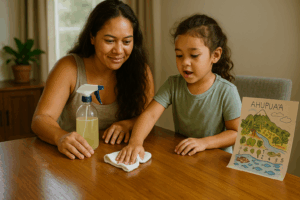
Step 4: Clean and Count
Test the cleaner on a safe surface, like a table or mirror. Let your keiki wipe (with supervision) and count the wipes: “How many times did we wipe? 1, 2, 3, 4, 5!” ( aligns with CCSS.MATH.CONTENT.K.CC.B.4.b). Talk about how the cleaner helps the ʻāina by keeping chemicals out of the ocean. Ask: “What does it smell like? How does it feel?” Connect it to the ahupuaʻa: “Noni and kukui are like treasures from our land!”
Step 5: Draw and Share
Have your keiki draw a picture of the ahupuaʻa, including plants like noni or kukui, water, and animals ( aligns with K.SL.4 and K-ESS3-1). Ask them to describe it: “What’s in your ahupuaʻa? How many plants did you draw?” Write the numbers (1–10) on their drawing to practice numerals (CCSS.MATH.CONTENT.K.CC.A.3). Share the cleaner with a neighbor or family member, explaining how it helps the ʻāina. For fun, decorate the cleaner jar with a drawing of a noni fruit or kukui nut, tying it to aloha ʻāina (love for the land).
Make It Fun
- Count More: Count ingredients, wipes, or plants in the ahupuaʻa drawing to reinforce numbers up to 20.
- Story Time: Read a book about the ahupuaʻa (like The Story of Hāloa by Malia Bohlin) to deepen the connection.
- Community Aloha: Share your cleaner or drawing with a local group like a hālau or environmental club to spread mālama ʻāina.
Safety Reminders
- Adults handle mixing and plant prep (noni can irritate skin; use gloves).
- Label containers and keep them out of reach of keiki.
- Never mix bleach with other ingredients—it creates toxic fumes.
- If gathering plants, consult kūpuna or the University of Hawaiʻi Master Gardener Program for respectful practices.
Why This Matters
This activity brings the ahupuaʻa to life for your kindergartener, showing how plants like noni and kukui are natural resources we can use thoughtfully. It helps keiki identify and describe resources, practice counting, and understand their kuleana to protect the ʻāina. By making cleaners together, you’re fostering laulima (cooperation) and teaching your child to care for Hawaii’s environment in a hands-on, culturally rich way.
Grab your jars, call your keiki, and let’s clean together with aloha!
Inspired by “Ahupuaʻa Community Connections & Ahupuaʻa Natural Resources Diagram,” Ka Pilina Noʻeau Hoʻomau.

